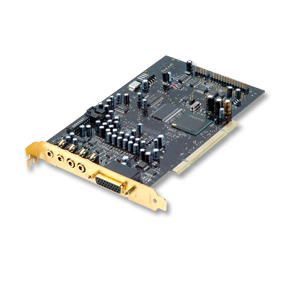
24-bit Analog-to-Digital conversion of analog inputs at 96kHz sample rate.One AD_LINK connector for linking to the audio card.DIN jack to connect Creative analog speaker systems with the wired remote control or Audio Control Pod that comes with the speakers.Shared line-level analog Line/Hi-Z input via 6.35 mm (1/4-inch) stereo jack.Shared line-level analog Line/Microphone input via 6.35 mm (1/4-inch) stereo jack.Headphone output and volume control via 6.35 mm (1/4-inch) stereo jack.Two standard MIDI female connectors for MIDI input and output.Two optical connectors for optical SPDIF input and output.Shared Auxiliary input/Phono input via RCA stereo jacks.Two RCA jacks for coaxial SPDIF input and output.26 pin AD_Link connector for linking to the X-Fi I/O Console (upgrade option).AUX_IN line-level analog input via 4-pin Molex connector.Line level out (Front / Rear / Center / Subwoofer / Rear Center) via 3 X 3.5mm mini jacks.FlexiJack (Performing a 3-in-1 function, Digital In / Line In / Microphone) via 3.5mm mini-jack.Extended I/O via Internal Drive-Bay Module.136dB SNR Internal Audio Processing Quality.Before we begin, we will go through Creative’s specifications. We’ve chosen to concentrate on Elite Pro.
#SOUND BLASTER X FI ELITE PRO PRO#
The two cards that we’ll be looking at today are the X-Fi Elite Pro and Extreme Music. First and foremost, the article will be about the differences between Audigy 4 Pro and X-Fi Elite Pro. Today we will take a look at what’s happened between the two chips, EMU10K (1/2) and EMU20K1, but also between the actual products, Audigy 2 ZS/Audigy 4 and X-Fi. In short, we, among many others, have had great expectations of the upcoming cards from Creative. It is true that Creative took a pretty big step when they went from the EMU10K1 (Live!) to the EMU10K2 (Audigy) but it wasn’t really a fundamental reinvention in the same way that we experience with the EMU20K1.

This has also given them the opportunity to improve performance and functionality in a more radical way than we experienced when Creative took the step from the Audigy to the Audigy 2 for example. What this means is that Creative has for the first time in many years had the opportunity to correct some problems that the EMU10K chips have been having since 1998. For example, the old SoundBlaster Live! uses the same fundamental technology just like the recent SoundBlaster Audigy 4 Pro. Keep in mind that it’s about seven years ago since Creative launched a completely new chip. X-Fi doesn’t just mean a bunch of new products with improved DA transformers and a newly designed breakout box, but more of a fundamental shift of generations that’s happening. Today we’ll be testing the Creative SoundBlaster X-Fi Elite Pro and also take a quick peek at X-Fi Extreme Music. Surely, it is hard to quantify sound card performance in the same way as we measure our other components, but it doesn’t make it less important. Sound cards can sometimes be almost forgotten when looking for the perfect benchmark results. Sound cards are not something we at NordicHardware test as often as motherboards, graphics cards or processors. Notice: There seems to have slipped through a few technical errors during the translation.


 0 kommentar(er)
0 kommentar(er)
